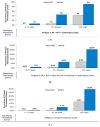Age Distribution, Comorbidities and Risk Factors for Thrombosis in Prader-Willi Syndrome
- PMID: 31936105
- PMCID: PMC7017326
- DOI: 10.3390/genes11010067
Age Distribution, Comorbidities and Risk Factors for Thrombosis in Prader-Willi Syndrome
Abstract
: Prader-Willi syndrome (PWS) is an imprinting disorder caused by lack of expression of the paternally inherited 15q11.2-q13 chromosome region. The risk of death from obesity-related complications can worsen with age, but survival trends are improving. Comorbidities and their complications such as thrombosis or blood clots and venous thromboembolism (VTE) are uncommon but reported in PWS. Two phases of analyses were conducted in our study: unadjusted and adjusted frequency with odds ratios and a regression analysis of risk factors. Individuals with PWS or non-PWS controls with exogenous obesity were identified by specific International Classification of Diseases (ICD)-9 diagnostic codes reported on more than one occasion to confirm the diagnosis of PWS or exogenous obesity in available national health claims insurance datasets. The overall average age or average age per age interval (0-17yr, 18-64yr, and 65yr+) and gender distribution in each population were similar in 3136 patients with PWS and 3945 non-PWS controls for comparison purposes, with exogenous obesity identified from two insurance health claims dataset sources (i.e., commercial and Medicare advantage or Medicaid). For example, 65.1% of the 3136 patients with PWS were less than 18 years old (subadults), 33.2% were 18-64 years old (adults), and 1.7% were 65 years or older. After adjusting for comorbidities that were identified with diagnostic codes, we found that commercially insured PWS individuals across all age cohorts were 2.55 times more likely to experience pulmonary embolism (PE) or deep vein thrombosis (DVT) than for obese controls (p-value: 0.013; confidence interval (CI) :1.22-5.32). Medi caid-insured individuals across all age cohorts with PWS were 0.85 times more likely to experience PE or DVT than obese controls (p-value: 0.60; CI: 0.46-1.56), with no indicated age difference. Age and gender were statistically significant predictors of VTEs, and they were independent of insurance coverage. There was an increase in occurrence of thrombotic events across all age cohorts within the PWS patient population when compared with their obese counterparts, regardless of insurance type.
Keywords: Prader–Willi syndrome; confirmatory ICD-9 diagnostic codes; deep venous thrombosis; individuals with exogenous obesity; insurance health claims; pulmonary embolism; thrombosis.
Conflict of interest statement
M.G.B. was a site principal investigator for the Zafgen clinical trials on Prader-Willi syndrome.
Figures




Similar articles
-
Long-term health outcomes in patients with Prader-Willi Syndrome: a nationwide cohort study in Denmark.Int J Obes (Lond). 2017 Oct;41(10):1531-1538. doi: 10.1038/ijo.2017.139. Epub 2017 Jun 21. Int J Obes (Lond). 2017. PMID: 28634363
-
Insulin resistance and obesity-related factors in Prader-Willi syndrome: comparison with obese subjects.Clin Genet. 2005 Mar;67(3):230-9. doi: 10.1111/j.1399-0004.2004.00392.x. Clin Genet. 2005. PMID: 15691361 Free PMC article.
-
Venous Thromboembolism in Prader-Willi Syndrome: A Questionnaire Survey.Genes (Basel). 2019 Jul 19;10(7):550. doi: 10.3390/genes10070550. Genes (Basel). 2019. PMID: 31331040 Free PMC article.
-
Prader-Willi syndrome: a review of clinical, genetic, and endocrine findings.J Endocrinol Invest. 2015 Dec;38(12):1249-63. doi: 10.1007/s40618-015-0312-9. Epub 2015 Jun 11. J Endocrinol Invest. 2015. PMID: 26062517 Free PMC article. Review.
-
Malignancies in Prader-Willi Syndrome: Results From a Large International Cohort and Literature Review.J Clin Endocrinol Metab. 2023 Nov 17;108(12):e1720-e1730. doi: 10.1210/clinem/dgad312. J Clin Endocrinol Metab. 2023. PMID: 37267430 Free PMC article. Review.
Cited by
-
Hypogonadism in Women with Prader-Willi Syndrome-Clinical Recommendations Based on a Dutch Cohort Study, Review of the Literature and an International Expert Panel Discussion.J Clin Med. 2021 Dec 10;10(24):5781. doi: 10.3390/jcm10245781. J Clin Med. 2021. PMID: 34945077 Free PMC article.
-
Systemic immune profile in Prader-Willi syndrome: elevated matrix metalloproteinase and myeloperoxidase and reduced macrophage inhibitory factor.Orphanet J Rare Dis. 2023 Jul 10;18(1):185. doi: 10.1186/s13023-023-02730-5. Orphanet J Rare Dis. 2023. PMID: 37430349 Free PMC article.
-
Thrombosis Risk History and D-dimer Levels in Asymptomatic Individuals with Prader-Willi Syndrome.J Clin Med. 2022 Apr 5;11(7):2040. doi: 10.3390/jcm11072040. J Clin Med. 2022. PMID: 35407648 Free PMC article.
-
A Case Report of Acute Saddle Pulmonary Embolism in Prader-Willi Syndrome.Cureus. 2024 Apr 2;16(4):e57466. doi: 10.7759/cureus.57466. eCollection 2024 Apr. Cureus. 2024. PMID: 38699101 Free PMC article.
-
Pharmacodynamic Gene Testing in Prader-Willi Syndrome.Front Genet. 2020 Nov 20;11:579609. doi: 10.3389/fgene.2020.579609. eCollection 2020. Front Genet. 2020. PMID: 33329716 Free PMC article.
References
-
- Butler M.G., Hartin S.N., Hossain W.A., Manzardo A.M., Kimonis V., Dykens E., Gold J.A., Kim S.J., Weisensel N., Tamura R., et al. Molecular genetic classification in Prader-Willi syndrome: A multisite cohort study. J. Med. Genet. 2019;56:149–153. doi: 10.1136/jmedgenet-2018-105301. - DOI - PMC - PubMed
Publication types
MeSH terms
LinkOut - more resources
Full Text Sources
Medical

